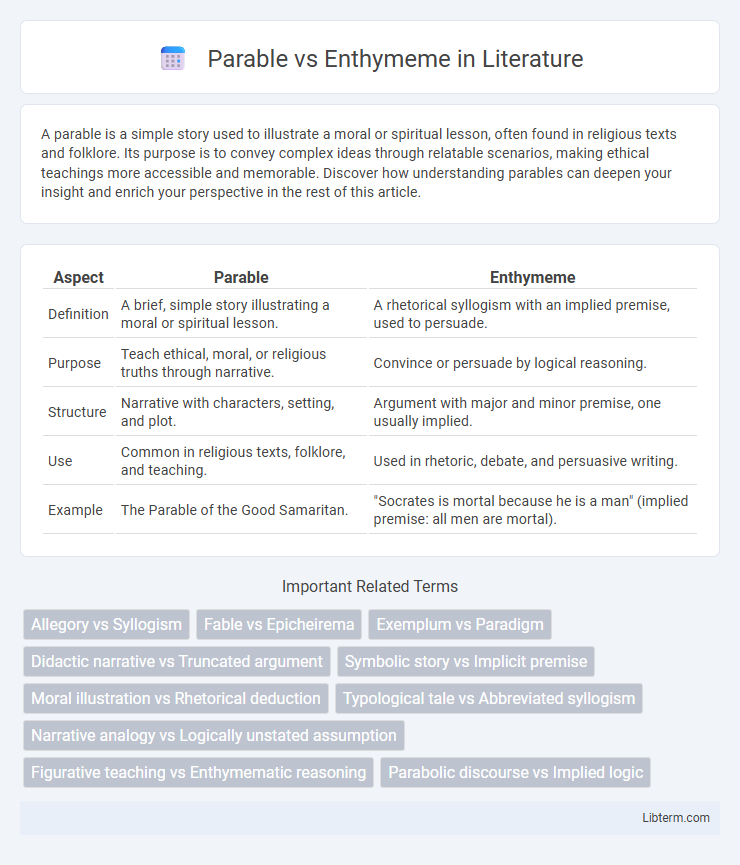A parable is a simple story used to illustrate a moral or spiritual lesson, often found in religious texts and folklore. Its purpose is to convey complex ideas through relatable scenarios, making ethical teachings more accessible and memorable. Discover how understanding parables can deepen your insight and enrich your perspective in the rest of this article.
Table of Comparison
| Aspect | Parable | Enthymeme |
|---|---|---|
| Definition | A brief, simple story illustrating a moral or spiritual lesson. | A rhetorical syllogism with an implied premise, used to persuade. |
| Purpose | Teach ethical, moral, or religious truths through narrative. | Convince or persuade by logical reasoning. |
| Structure | Narrative with characters, setting, and plot. | Argument with major and minor premise, one usually implied. |
| Use | Common in religious texts, folklore, and teaching. | Used in rhetoric, debate, and persuasive writing. |
| Example | The Parable of the Good Samaritan. | "Socrates is mortal because he is a man" (implied premise: all men are mortal). |
Definition of Parable
A parable is a succinct, didactic story designed to illustrate moral or spiritual lessons through metaphorical or symbolic narratives, often found in religious texts like the Bible. It differs from an enthymeme, which is a rhetorical syllogism that presents an argument with one premise implied rather than stated. Parables use storytelling to engage listeners emotionally and cognitively, fostering reflection and insight beyond straightforward logical reasoning.
Definition of Enthymeme
An enthymeme is a rhetorical syllogism that contains an implied premise or conclusion, making it a concise and persuasive argument often used in everyday discourse. Unlike a parable, which is a narrative designed to illustrate a moral or spiritual lesson through storytelling, an enthymeme relies on the audience's ability to fill in the missing component to complete the argument. This implicit nature of enthymemes makes them effective in debates and persuasive speech by engaging the audience's reasoning process.
Historical Origins: Parable vs Enthymeme
Parables have roots in ancient religious and philosophical traditions, prominently used by figures like Jesus Christ and Aesop to convey moral lessons through simple, relatable stories. Enthymemes originate from Aristotle's rhetorical theory in classical Greece, serving as argumentative syllogisms that omit one premise for audience engagement. While parables function as narrative didactic tools, enthymemes operate as logical constructs aimed at persuasion within rhetoric.
Structural Differences
A parable is a simple story with a clear moral lesson, structured around a narrative that illustrates a general truth through allegory or analogy. An enthymeme, in contrast, is a rhetorical syllogism used in argumentation where one premise is often implied rather than explicitly stated, relying on the audience's ability to fill in the gap. The structural difference lies in parables employing narrative form to convey meaning, while enthymemes use a logical form with an unstated premise to persuade.
Purpose and Application
Parables serve as illustrative stories designed to convey moral or spiritual lessons through relatable narratives, making complex ideas accessible and memorable for diverse audiences. Enthymemes function as truncated arguments that rely on implied premises, engaging the audience's reasoning skills to persuade by encouraging active participation in logical deduction. Both devices are applied strategically in rhetoric and teaching, with parables appealing emotionally and illustratively, while enthymemes foster critical thinking and argumentative effectiveness.
Role in Rhetorical Argumentation
A parable employs narrative storytelling to illustrate moral or ethical lessons, making abstract concepts relatable and persuasive through vivid examples, thus enhancing emotional engagement in rhetorical argumentation. An enthymeme functions as a truncated syllogism that relies on shared knowledge or assumptions between speaker and audience, fostering logical persuasion by inviting the audience to complete the argument. Both serve distinct roles in rhetoric: parables appeal to values and emotions, while enthymemes prioritize logical inference and implicit reasoning.
Use in Literature and Speech
Parables employ narrative storytelling with symbolic characters and events to convey moral or spiritual lessons, commonly found in religious texts and literature for illustrative impact. Enthymemes function as rhetorical syllogisms used in persuasive speech, where one premise is implied, allowing audiences to engage in reasoning and draw conclusions. Both techniques enhance communication by embedding deeper meanings, with parables appealing through vivid allegory and enthymemes through logical inference.
Effectiveness in Persuasion
Parables utilize storytelling to engage emotions and imagination, making complex moral lessons memorable and relatable, thereby enhancing persuasive impact through vivid, narrative-driven understanding. Enthymemes rely on implied logic and shared assumptions, prompting audiences to actively complete the argument, which increases persuasion by fostering critical thinking and personal agreement. Combining emotional resonance of parables with the logical appeal of enthymemes often results in highly effective, multifaceted persuasion strategies.
Interpretative Challenges
Parables present interpretative challenges due to their layered symbolism and reliance on cultural or historical contexts, making the extraction of a singular moral message complex. Enthymemes, as truncated syllogisms, pose difficulties because the implicit premises require the audience to infer unstated assumptions, leading to potential ambiguity in logical conclusions. The interpretative complexity of both forms demands careful analysis of context and underlying intent to accurately derive meaning.
Modern Examples and Relevance
Parables and enthymemes serve distinct roles in modern communication, with parables often used in storytelling and marketing to convey moral lessons through relatable narratives, such as Google's "The Self-Driving Car" campaign illustrating innovation and caution. Enthymemes are prevalent in political speeches and social media debates, where implied premises engage audiences in critical thinking, exemplified by campaigns suggesting policy success without explicit evidence. The relevance of both lies in their ability to simplify complex ideas, making persuasive communication more accessible and impactful in contemporary society.
Parable Infographic

 libterm.com
libterm.com